Paper Printing Services Signboards around Campus Building (A Case of Multimodal Linguistic Landscape)
on
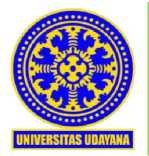
e-Journal of Linguistics
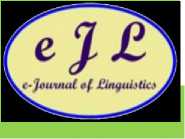
Available online at https://ojs.unud.ac.id/index.php/eol/index
Vol. 17, No. 2, July 2023, pages: 133--142
Print ISSN: 2541-5514 Online ISSN: 2442-7586
https://doi.org/10.24843/e-jl.2023.v17.i02.p01
Paper Printing Services Signboards around Campus Building (A Case of Multimodal Linguistic Landscape)
Gabriel Fredi Daar
Universitas Katolik Indonesia Santu Paulus Ruteng, Indonesia Email: freddydaar@gmail.com
Article info
Received Date: 5 January 2023
Accepted Date: 3 February 2023
Published Date: 31 July 2023
Keywords:*
paper printing services, signboards, multimodal analysis, linguistic landscape
Abstract*
Micro, Small and Medium Enterprises are currently becoming one of the concerns and priorities of the Indonesian government. Every Micro, Small and Medium Enterprises (MSME) actor builds a business in a location that is considered to have the potential to generate profits. One type of MSME is a paper printing services. This research is a case study of landscape linguistics with a multimodal approach. This study aims to analyze the representation meaning, interactional meaning and compositional meaning of outdoor signs on paper printing business signboards at the Unika Santu Paulus Ruteng campus building surrounding; in the east, south and west of the campus building. The results showed that all outdoor sign data on the signage were verbal signs supported by several contrasting color backgrounds. The representation meaning of the signboards represents the type of business being run, namely the paper printing services. It is indicated by the two main keywords that appear on every signboard, including the word “print or printing” and “photocopy/copi”. In the aspect of compositional meaning, all the data on the signboards contains informative value. Information is placed in a non-linear text framing position and is not placed sequentially. In the salience aspect, the verbal sign in the form of the business name is placed at the top position and is the most salience element in the sign. Placement and a more salience verbal signs aim to make it easier for viewers to see the place of business as well as show the identity and type of business being run. On the other hand, the use of abbreviations on the signboards of a “startup business” creates confusion if it is not accompanied by clear additional information.
Small and Medium Enterprises (SMEs) are a form of business that is seen from the scale of household businesses and small businesses only have a number of employees between 119 people. It’s different from medium-sized businesses which have between 20-99 employees (BPS, 2004) in (Jauhari, 2010). Micro, Small and Medium Enterprises (MSMEs) have made e a significant contribution to spurring Indonesia's economic growth. This is because the absorption of SMEs to the workforce is very large, and they are close to middle-down class people (Jauhari, 2010; Insani, Barus, & Lubis, 2021).
From an economic perspective, for the last 23 years (1997-2020), MSMEs with all their advantages and disadvantages have become the basis of the national economy and a shield against the shocks of the crisis that has occurred until now (Herispon & Hendrayani, 2018). SMEs are the backbone of the Indonesian economy, this is shown by the number of SMEs until 2019 reaching around 62 million. SMEs in Indonesia are very important for the economy because they contribute 60 percent of GDP and accommodate 97 percent of the workforce (Onainor, 2019).
In the midst of the rapid development of MSMEs, their movement has decreased due to the emergence of Covid-19 in early 2020, which has a direct impact on economic turnover, especially for MSMEs (Aliyani Firdaus et al., 2020). Therefore, micro, small and medium businesses need a business development strategy so that businesses can grow, especially in developing countries such as Indonesia (Andriyanty, 2021).
Ruteng City is a small town located in the province of East Nusa Tenggara, Indonesia. As a small town, Ruteng is the center of various social activities, including educational activities. There are a number of secondary schools and several universities in this city where people from various cities and villages receive education.
Unika Santu Paul Ruteng is one of the universities located in the middle of Ruteng City. There are thousands of students studying there from various regions in Indonesia and from various villages around Ruteng. Unika Ruteng became the center of public attention. This happens because this university is one of the big universities in NTT. The large number of students turned out to be an opportunity for micro, small and medium businesses to make students the target consumers of a particular market.
By reading this opportunity, several types of Small and Medium Enterprises (SMEs) have grown and developed around the Unika Santu Paulus Ruteng campus as a new social change in the city of Ruteng. One type of business that is quite developed that is relevant to the needs of students as consumers is paper printing services. Skokan, Pawliczek, & Piszczur (2013) said that businesses that implement strategic management will operate better than other businesses that do not care about strategy. Business actors carry out various strategies to increase consumer interest and income, such as promotions through social media and the manufacture of signage that is displayed in front of the place of business.
Reading this phenomenon as a multidisciplinary phenomenon, researchers are interested in analyzing the language and signs used by producers or Micro, Small and Medium Enterprises actors on paper printing business signboards using the multimodal analysis proposed by Kress & Leuwen (2006).
Some scholars have conducted research on Landscape Linguistics with multimodality approach. Chen (2016) conducted a study by using a multimodal analysis of linguistic landscape in Robot Open Space, Japan. There were some insights and contribution provided by the study. First, there was a shift of analytical attention of linguistic landscape study from the outdoor linguistic landscape to the indoor linguistic landscape. The new angel of LL analysis was provided, and further the scenery of linguistic landscape was expanded. Second, the current theoretical model is quite rare. It’s then enriched by the newly establish analytical framework of “multimodal model for linguistic landscape analysis”. Similarly, Mulyawan (2020) conducted a study by using multimodal analysis of outdoor signs in Kuta Bali. There were three outdoor billboard signs that he used as the data for analysis. The study found that the actors represented in outdoor signs are all salience. It wasn’t only found as an icon of human but also a figure, a symbol, or a voice index as replacement of callout statement. The interaction meaning of outdoor signs showed that with their salience, they are in the position of demand and/or offering
information, service and product. And in the composition processes, the images are salience with centered position and non linear text framing. They had various information values. Other study conducted by Pan (2015) on multimodality and contextualisation in advertisement translation. The study used billboards in Hong Kong Li Pan, Guangdong University of Foreign Studies as the data for analysis. It focused on the role of non-verbal elements in advertisements. Translator needs to contextualise the linguistic messages in advertisement translation. The study also explored how extra linguistic used to translate linguistic messages. The study showed that the multimodal nature of billboard advertising determines the use of method of translation to mediate different cultures. The study concludes the extra-linguistic elements are other aspects that can be considered in translating the text pf advertisement. Hence, translations are not merely influenced by multimodal aspects of the texts they translate.
Referring to the previous research data above, studies with a multimodality approach on outdoor signs is important for certain purposes according to the context and situation of the community where the sign is made. Through conducting several studies using a multimodal approach in different places, contexts and cultures, it can enrich the theoretical framework and understanding of the linguistic landscape with a multimodality approach. However, it is indicated that research with a multimodal approach that focuses on paper printing business signboards has never been carried out. The paper printing services is one of the types of micro, small and medium enterprises that are currently a priority for the Indonesian government. MSMEs are considered as the foundation that can improve the Indonesian economy. One of the determinants of the success of MSMEs is the implementation of strategies that can attract customers. Thus, in this study, researchers analyzed linguistically the outdoor signs on the signboards of a paper printing business that has already been running around the Unika Ruteng campus building. This study contributes significantly to the use of verbal signs and images that usually appear on business signage. The use of verbal signs and images that are in accordance with the type of business, proper positioning and composition also influence the viewer's perception of the business which is explicitly represented on the signboards of the business.
This study used a descriptive qualitative method which aims to describe how the Multimodal approach is used on signboards of paper printing services. The data in this study were in the form of texts and images of signboards of paper printing services located surrounding the campus building of Universitas Katolik Indonesia Santu Paulus Ruteng , Flores Indonesia.
-
2.1 Research Subject and Object
The subject of this study is the signboards of paper printing business that can be found in the east, south and west of the campus building of Universitas Katolik Indonesia Santu Paulus Ruteng, Indonesia. The objects of this study are representation meaning, interaction meaning and composition meaning of the paper printing business signboards.
-
2.2 Technique of Data collection and Analysis
In the process of collecting data, it’s important to plan and undertake certain technique that helps researchers obtain the research data. In the study of outdoor signs, the information was gathered by the researcher by conducting visual perception and note-taking.
In conducting this study, there were some steps taken by the researchers to collect the data. The first step was selecting the signboards of paper printing business. In this step, the researchers chose the signboards that are clear in shading. It’s done to help researchers interpret accurately the representations carried out by the signs. As there were seven signboards found in campus building surrounding, the researchers used total sampling as the sampling technique. Thus, all the paper printing business signboards were taken as the data to be analyzed. Second, the researchers
took the picture of the signboards. Later, all components in the signs were read and rechecked carefully, then relevant information were selected to answer the research questions. Final step was drawing conclusions.
The data of the study were analyzed based on the theory of multimodal analysis proposed by Kress and Leeuwen (2006).
Based on the data collected, there are seven paper printing business signboards at the Unika Santu Paulus Ruteng campus bulding surrounding with each distributions three in the east, two in the south and two in the west of the campus. The signboards were collected, then analyzed using a multimodal analysis approach to understand the representation meaning, interaction meaning and composition meaning of the verbal signs as proposed by Kress and Leuven (2006).
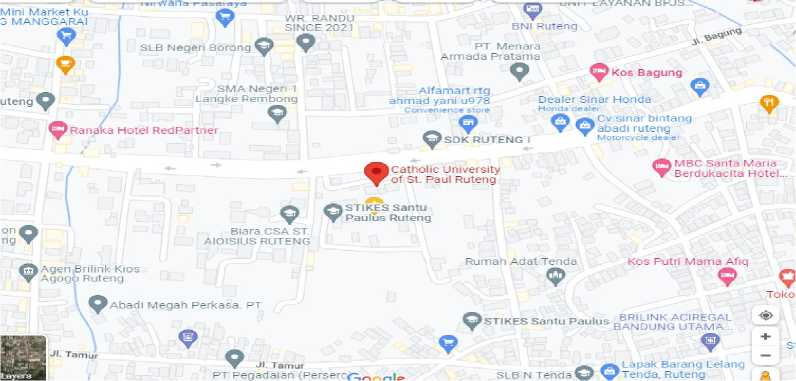
Kos Bagung
SLB Negeri Borong
uteng^
WR. RANDU SiNCE 2021
SMA Negeri 1 La ng ke Rem bo ng
9
BNl Ruleng
Alfamart rtg ahmad yani u978
Dealer Sinar Honda Honda dealer
^⅛ ^‰ Cv sinar bintang if ⅛F abadi ruteng
^^Abadl Megah Perk;
^¾AgenlBriiink Kios ▼ Agogo Ruteng
Catholic University of St. Paul Ruteng
9 STiKES Santu
y Paulus Ruteng Biara CSA ST.
A∣oιsιus ruteng
χ∙⅛ Lapak Barang Leiang
SLB N Tenda ⅝r Tenda, Ruteng
Figure 1. Map of research location
According Kress and Leuven (2006), representational meaning consists of narrative representation and conceptual representation. By referring to the two classifications of representational meaning, this study only analyzed the narrative representation aspect of the signboards since verbal signs dominantly appear on the signs. The narrative aspect shows the message of the action performed by all the actors or characters involved in the image. Mulyawan (2020) stated that verbal signs are considered narrative representations because they function as an index of statements spoken by anonymous characters.
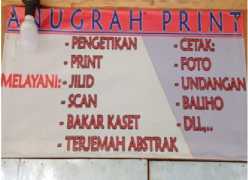
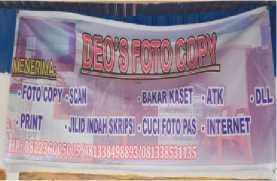

Figures 3.1.1
Based on the data, it can be seen that all paper printing business signboards have verbal signs that appear dominantly on each sign. The appearance of the verbal sign is seen in the business name which is generally placed at the top of each sign with a larger font size. The name reflects the identity and type of business services provided. Therefore, it is clear that there are at least two keywords that refer to the type of business being run which is represented in the business name, namely the word “print or printing” and “photocopy/copy”. These two keywords indicate that the type of business accepts orders for paper printing, photocopying and other relevant orders that are explicitly written on the order list on the signboards.
In the context of the reactional process, each signboard uses various writing colors with a specific purpose and intention. Bright colors are commonly used in business names including red and blue (see signboards of D'best Printing and Bina Usaha NF Cannon in Figure 4.1.5, Anugerah Print in Figure 4.1.4, and Sinar Rejeki Collection in Figure 4.1.1). These two colors were chosen based on the consideration of the clarity of the writing which makes it easier for the viewer to see and understand the information conveyed through the sign. In addition, the two colors are used to attract consumers to use their business services. On the other hand, there is a signboard (see Atrivm Photocopy signboard in Figure 4.1.2) that uses unclear colors in the writing of the business name, and a color background is not supportive. The colors used give messages that are not conveyed clearly to the viewer. The use of unclear colors on the verbal signs causes less and even lost opportunities for viewers to get information about the type of business being run. The next impact is a shortage and even loss of customers.
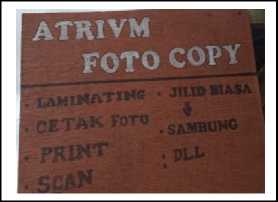
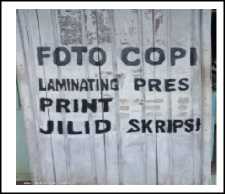
Figures 3.1.2
In addition, there is one signboard (see figure 4.1.2) which does not include the name of the business. The producer only writes down the type of order received at the sign including Foto Copi (photocopy), laminating pres (laminating press), print, and Jilid skripsi (thesis binding). By referring to the reactional process theory, the four verbal signs phrases in the sign represent information to viewers and customers that the business accepts orders for paper printing, photocopying and other relevant orders even though they do not use name on the signboards. However, various signs in public spaces reflect and regulate the spatial order in which they operate. Sociological, cultural, sociolinguistic, and political features of space will determine how signs look and work, and signs will also play a role in spatial organization and regulation by determining who the sign recipients are (Erikha, 2018). Name is an identity and branding that has informative and selling value. In addition, placing name on the signboard makes it easier for consumers to recognize the type of business that is being run. Thus, by not placing names on the signboard, it allows viewers or consumers not to know the business type, reduces interest in using services, and reduces the popularity of the business. Moreover, it is also seen that the signboard does not use a beautiful design and looks outdated.
Another aspect of the reactional process found was the use of foreign languages on paper printing business signboards. It can be seen in the use of the word “print or printing” and “photocopy”. If viewed from the aspect of the location where the outdoor sign is placed, the use of a foreign language does not indicate the identity of the business owner's territory. However, the use of foreign languages emphasizes other aspects and orientations. Piller (2001, 2003) cited in (Cenoz & Gorter, 2008) stated that the use of English in commercial signs brings connotation values of international orientation, future orientation, success, refinement or fun orientation. Referring to Piller's view (2001, 2003), the use of a foreign language on paper printing business signboards emphasizes the orientation of success and business pleasure. The use of foreign languages follows the trend of vocabulary that is currently popularly used and is more accepted in the community. This allows consumers to better understand the intent and type of business represented on the signage.
Kress and Leeuwen (2006) stated that there are three elements composed in interaction: contact, social distance, and attitude. The contact element identifies two types of images: demand and offer. Meanwhile, there are three types of social distance; intimate, social and impersonal. Moreover, the attitude has two subtypes: subjectivity and objectivity (Chen, 2016). Mulyawan (2020) further stated that the interaction process is the intended meaning given by the producer of the sign to the audience or viewer.
In the Contact element, the signboards outdoor signs shows offer. Sign producers provide paper printing business service offerings to customers. Due to its placement is around campus, the offer is addressed to students as the main customers. It is in accordance with the needs of
students who usually use the services of a paper printing business to print out assignments and final paper.
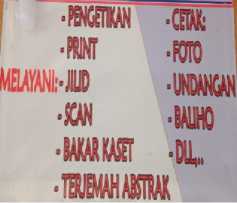
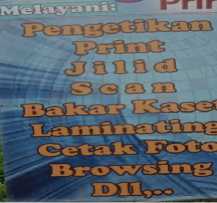
-
■ ; - FOTOCOpy HITAM PUTIH i WARNA f -SCAN A PRINT HITAM PUTIH & WARNA
-
■ ■ LAMINATING ∣A4, F4, A3, A3+, dll) I -PERCETAKAN BUKU, UNDANGAN (NIKAH, f , SAMBUT BARU, dll), PAPAN NAMA DADA, ID CARD, dll
-
■ ANEKA JILID :
I * LAKBAN VJARNA
-
• SPIRAL KAWAT & PLASTIK
-
* SOFTCOVER/PROPOSAL/SAMBUNG
-
* HARDCOVER / SKRIPSI / ISTIMEWAH tLEMPANASIBUKU
Figures 3.2.1
In line with the contact element, interaction attitude represents an objective attitude. Producers intentionally create business signage to provide certain information to viewers. All signs provide the same information about the existence of a paper printing business at the place where the signboard is stored. Furthermore, the sign provides additional information about other
139 services that are explicitly provided on the list of services on the signboards such as laminating press, thesis binding, invitation letter design, many others.
In the aspect of social distance, verbal signs showed public distance of social relations. It is clear that there are no visual signs of human icons that show an open social relationship between verbal signs and viewer of the sign. The viewer is a paper printing service user, both students as the main target users and others.
(Kress and Leuwen (2006) stated that compositional meaning consists of three aspects including information value, salience, and framing. All data contained in the paper printing business signboards contains informative value. The information is placed in a non-linear text framing position. Data and information are not placed sequentially. It is in accordance with the information type conveyed through the signboards which functions as an offer to the type of business served to customers.
In the salience aspect, it can be seen that the verbal sign in the form of the signboards placed at the top position and is the most salience element in the sign. The placement and size of the more salience verbal signs aim to make it easier for viewers to see the place of business as well as show the identity and type of business being run. This is supported by the contrasting background color that caused the sign to be more attractive and easier to see.
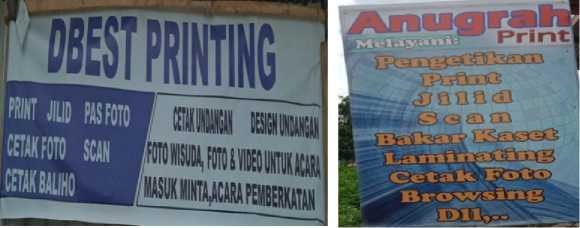
Figures 3.3.1
On some signboards, it can be seen that the verbal sign is placed in the middle position of the sign with the size and thickness of the letters protruding. This shows that the business name is the center of attention which is expected to attract more customers to know and come to use the services of a sign maker.

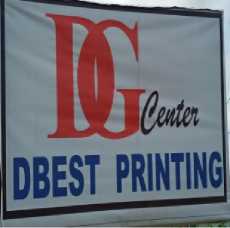
Figures 3.3.2
On the other hand, using verbal signs of abbreviations on the "DG" sign on D'best Printing and NF on "Bina Usaha" in a more salience sizes raises questions and even confusion for viewers. However, information about the type of business can be obtained through a word or
phrase placed at the bottom of the sign “printing and photocopy” which refers to businesses that offer paper printing services and other relevant types of services.
This research focuses on the multimodality analysis of outdoor signs on paper printing business signboards as a type of micro, small and medium enterprises around campus which has never been studied before. Through conducting this study using a multimodal approach in different places, contexts and cultures, it can enrich the theoretical framework and understanding of the linguistic landscape with a multimodality approach. The use of verbal signs and images proportionally aims to influence the viewer to come to use paper printing services. The use of certain lexicons such as the "center" implicitly confirms that the business has several branches that are managed professionally. On the other hand, the use of unclear verbal signs and unrepresentative images can reduce the message to be conveyed to the viewer. Thus, with reference to the context of this study, the multimodality approach can be applied to outdoor signs on the nameplates of micro, small and medium enterprises, especially in paper printing businesses around campus buildings. Representation, interpretation and composition as proposed by Kress & Leuwen (2006) are important aspects to be able to communicate certain messages to viewers who will use the available paper printing services.
The researchers would like to thank all parties who have contributed to the data collection process for this research.
Based on the results of the analysis, it can be concluded that the use of outdoor signs on paper printing business signboards around campus building uses more verbal signs than images. With a multimodal analysis approach, the outdoor sign is studied from the aspect of representation meaning, interaction meaning and composition meaning. In the aspect of representation meaning, the use of verbal signs aims to convey information clearly in the form of offering types of business services to the viewer so that it is easier for them to catch the message and information available on the sign. In the aspect of interactional meaning, the outdoor sign uses a contact element that has an offer value. The sign producer provides a sign in the form of a signboard to offer a certain type of business to the viewer. It’s explicitly written as the list of services on the signboard. Meanwhile, in the aspect of compositional meaning, the use of more salience verbal signs, and placed at the top of signs aims to indicate the type and identity of the business. In addition, the use of verbal signs supported by a contrasting color background makes the signage attractive for customers to see.
Aliyani Firdaus, S., Fadilah Ilham, I., Putri Aqidah, L., Aliyani Firdaus, S., Agung Dwi Astuti,
-
S., & Buchori, I. (2020). Strategi UMKM untuk Meningkatkan Perekonomian selama Pandemi Covid-19 pada saat New Normal. OECONOMICUS Journal of Economics, 5(1), 46–62. https://doi.org/10.15642/oje.2020.5.1.46-62
Andriyanty, R. (2021). Analisis Strategi Pengembangan Bisnis Umkm Warteg Sekitar Kampus Ibi Kosgoro 1957 Jakarta. MEDIASTIMA, 27(1), 82–95.
Chen, S. (2016). Linguistic landscape and space: A multimodal analysis of linguistic landscape in robot open space. International Journal of Applied Linguistics and English Literature, 5(6), 90–98. https://doi.org/10.7575/aiac.ijalel.v.5n.6p.90
Erikha, Fajar. (2018). Konsep Lanskap Linguistik Pada Papan Nama Jalan Kerajaan (Râjamârga):
Studi Kasus Kota Yogyakarta. Paradigma Jurnal Kajian Budaya, Vol 8 No. 1, pp. 38 - 52
Cenoz, J., & Gorter, D. (2008). The linguistic landscape as an additional source of input in second language acquisition. IRAL - International Review of Applied Linguistics in Language Teaching, 46(3), 267–287. https://doi.org/10.1515/IRAL.2008.012
Herispon, & Hendrayani. (2018). Kontribusi dan Eksistensi Usaha Mikro Kecil dan Menengah di
Indonesia. Jurnal Daya Sing, 7(1), 40–56. Retrieved from
https://www.ejournal.kompetif.com/index.php/dayasaing/article/download/633/468
Insani, F., Barus, B., & Lubis, D. P. (2021). Zona Pengembangan Usaha Mikro Kecil dan Menengah (UMKM) Pengolah Makanan di Kota Bekasi. Journal of Regional and Rural Development Planning, 5(1), 61–76. https://doi.org/10.29244/jp2wd.2021.5.1.61-76
Jauhari, J. (2010). Upaya Pengembangan Usaha
Kecil dan Menengah (UMKM) dengan Memanfaatkan E-Commerce. Jurnal Sistem
Informasi, 2(1), 159–168. Retrieved from
https://ejournal.unsri.ac.id/index.php/jsi/article/view/718
Kress, G., & Van Leeuwen, T. (2006). Reading Image The grammar of visual design. London:
Routledge. https://doi.org/10.1007/1-4020-0613-6_15545
Mulyawan, I. W. (2020). Reading visual design of outdoor signs in Kuta (A case study of multimodal linguistic landscapes). Cogent Arts and Humanities, 7(1).
https://doi.org/10.1080/23311983.2020.1748987
Onainor, E. R. (2019). Strategi Pengembangan
Kompetisi Usaha Kecil Menengah di Kabupaten Jombang. Jurnal AKRAB JUARA, Volume 5 Nomor 4 Edisi November 2020 (77-85), 1(November), 105–112.
Pan, L. (2015). Multimodality and contextualisation in advertisement translation: A case study of billboards in Hong Kong. Journal of Specialised Translation, (23), 205–222.
Skokan, K., Pawliczek, A., & Piszczur, R. (2013). Strategic Planning and Business Performance of Micro, Small and Medium-Sized Enterprises. Journal of Competitiveness, 5(4), 57–72. https://doi.org/10.7441/joc.2013.04.04
Biography of Author

Gabriel Fredi Daar is an English lecturer at Faculty of Health Science, Universitas Katolik Indonesia Santu Paulus Ruteng, Indonesia. He obtained his Master’s degree in English Education from Unindra PGRI Jakarta in 2015. He currently is a Ph.D student of linguistic at Udayana University, Bali, Indonesia. He received Lembaga Pengelola Dana Pendidikan (LPDP) scholarship or the Indonesian Endowment Fund for Education scholarship under the Indonesian Ministry of Finance to enrol the Ph.D study program in 2021. His research interest is in sociolinguistics, pragmatics and language teaching.
Email: freddydaar@gmail.com
Discussion and feedback